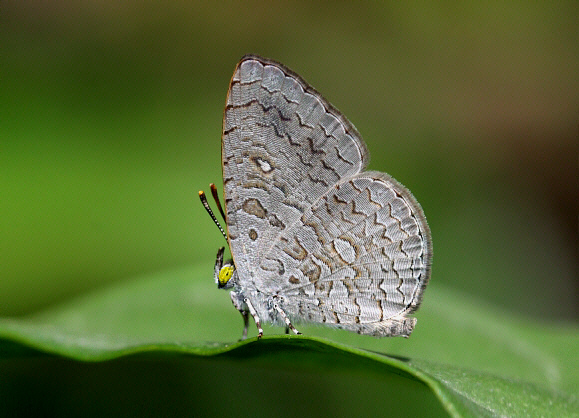
Introduction
The Apefly is one of several similar species in the tribe Miletini, which are characterised by having attractively mottled and striated patterns on their underside wings, a long thin abdomen, a very long proboscis, and erect labial palpi.
The name Apefly refers to the dorsal view of the pupa, which bears an astonishing resemblance to the face of a rhesus monkey. The Thai vernacular name Phi Suea Dak Dae Hua Ling literally means ‘the butterfly whose pupa resembles a monkey head’.
There are 7 Spalgis species, of which 3 are wholly African in distribution, one is endemic to Papua New Guinea, one is endemic to the Philippines, and two: baiongus and epius, are found in India.
In common with other members of the subfamily Miletinae, this species is hemipterophagous, i.e. the caterpillar and adult butterfly both feed exclusively on Hemiptera, or Hemipteran by-products.
A great deal remains to be learnt about the ecology of the Miletinae. It is known that the adults and larvae of most species live in association with ants and that most feed parasitically or carnivorously on aphids, coccids, psyllids or membracids. It is probable that all Miletinae species are involved in complex 3-way symbiotic relationships with ants and Hemiptera.
Habitats
This species inhabits rainforest and humid deciduous forest at elevations between about 100-500m.
Lifecycle
The eggs are laid amidst colonies of mealybugs Planococcus ( Pseudococcidae ). Several are laid, one at a time, in each colony. The resulting larvae do not at any stage of their growth eat plant matter, instead they feed parasitically or as predators, on the bugs. The bodies of the larvae are coated with white waxy filaments which adhere to their setae, making it very difficult to distinguish them from the mealybugs themselves. When tiny the larvae feed on the eggs of the bugs, but when larger they feed on the nymphs and adult females.
Adult behaviour
The butterflies are sedentary in behaviour. The flight is weak, and they only cover short distances when flying. They are normally encountered solitarily, or in very low numbers, and can be seen at rest on the foliage of bushes in the undergrowth. Males perch on foliage at a height of about 1-2m, and use these vantage points to await passing females. Often 2 or 3 males will be found in close proximity – when males meet they chase each other rapidly back and forth until one or the other submits to bullying and flies away.
